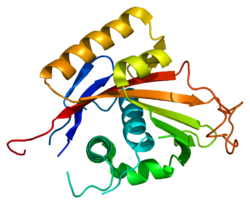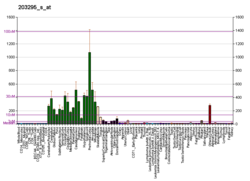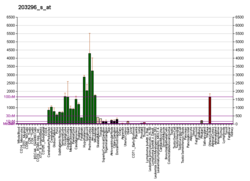Protein-coding gene in the species Homo sapiens
| ATP1A2 |
|---|
 |
| Identifiers |
|---|
| Aliases | ATP1A2, FHM2, MHP2, ATPase Na+/K+ transporting subunit alpha 2, DEE98, FARIMPD |
|---|
| External IDs | OMIM: 182340; MGI: 88106; HomoloGene: 47947; GeneCards: ATP1A2; OMA:ATP1A2 - orthologs |
|---|
| Gene location (Human) |
|---|
 | | Chr. | Chromosome 1 (human)[1] |
|---|
| | Band | 1q23.2 | Start | 160,115,759 bp[1] |
|---|
| End | 160,143,591 bp[1] |
|---|
|
| Gene location (Mouse) |
|---|
 | | Chr. | Chromosome 1 (mouse)[2] |
|---|
| | Band | 1 H3|1 79.6 cM | Start | 172,099,276 bp[2] |
|---|
| End | 172,125,631 bp[2] |
|---|
|
| RNA expression pattern |
|---|
| Bgee | | Human | Mouse (ortholog) |
|---|
| Top expressed in | - external globus pallidus
- trigeminal ganglion
- superior vestibular nucleus
- ventral tegmental area
- endothelial cell
- subthalamic nucleus
- caudate nucleus
- vastus lateralis muscle
- putamen
- middle frontal gyrus
|
| | Top expressed in | - ciliary body
- iris
- substantia nigra
- ankle
- medial vestibular nucleus
- sternocleidomastoid muscle
- medial geniculate nucleus
- digastric muscle
- olfactory tubercle
- globus pallidus
|
| | More reference expression data |
|
|---|
| BioGPS | 
 | | More reference expression data |
|
|---|
|
| Gene ontology |
|---|
| Molecular function | - steroid hormone binding
- nucleotide binding
- chaperone binding
- potassium ion binding
- sodium ion binding
- P-type sodium:potassium-exchanging transporter activity
- metal ion binding
- ATPase-coupled cation transmembrane transporter activity
- ATPase activity
- protein binding
- hydrolase activity
- ATP binding
- P-type potassium transmembrane transporter activity
| | Cellular component | - cytoplasm
- extracellular vesicle
- integral component of membrane
- endosome
- membrane
- intercalated disc
- T-tubule
- myelin sheath
- plasma membrane
- dendritic spine
- synapse
- sodium:potassium-exchanging ATPase complex
- caveola
- neuron projection
- sarcolemma
| | Biological process | - visual learning
- cellular response to steroid hormone stimulus
- regulation of muscle contraction
- regulation of cardiac conduction
- cardiac muscle contraction
- regulation of smooth muscle contraction
- sodium ion transport
- regulation of the force of heart contraction
- regulation of cardiac muscle contraction by regulation of the release of sequestered calcium ion
- negative regulation of heart contraction
- cellular sodium ion homeostasis
- adult locomotory behavior
- sodium ion export across plasma membrane
- negative regulation of striated muscle contraction
- cell communication by electrical coupling involved in cardiac conduction
- response to nicotine
- response to glycoside
- ion transport
- cellular potassium ion homeostasis
- regulation of blood pressure
- regulation of respiratory gaseous exchange by nervous system process
- potassium ion transport
- regulation of cardiac muscle cell contraction
- ion transmembrane transport
- ATP metabolic process
- cellular response to mechanical stimulus
- regulation of striated muscle contraction
- membrane repolarization
- negative regulation of calcium ion transmembrane transport
- regulation of vasoconstriction
- neurotransmitter uptake
- negative regulation of calcium:sodium antiporter activity
- locomotion
- regulation of glutamate uptake involved in transmission of nerve impulse
- regulation of synaptic transmission, glutamatergic
- relaxation of cardiac muscle
- membrane depolarization during cardiac muscle cell action potential
- negative regulation of cytosolic calcium ion concentration
- potassium ion import across plasma membrane
- establishment or maintenance of transmembrane electrochemical gradient
- transport
| | Sources:Amigo / QuickGO |
|
| Orthologs |
|---|
| Species | Human | Mouse |
|---|
| Entrez | | |
|---|
| Ensembl | | |
|---|
| UniProt | | |
|---|
| RefSeq (mRNA) | | |
|---|
| RefSeq (protein) | | |
|---|
| Location (UCSC) | Chr 1: 160.12 – 160.14 Mb | Chr 1: 172.1 – 172.13 Mb |
|---|
| PubMed search | [3] | [4] |
|---|
|
| Wikidata |
| View/Edit Human | View/Edit Mouse |
|
Sodium/potassium-transporting ATPase subunit alpha-2 is a protein which in humans is encoded by the ATP1A2 gene.[5][6]
Function
The protein encoded by this gene belongs to the family of P-type cation transport ATPases and to the subfamily of Na+/K+-ATPases. Na+/K+-ATPase is an integral membrane protein responsible for establishing and maintaining the electrochemical gradients of Na and K ions across the plasma membrane. These gradients are essential for osmoregulation, for sodium-coupled transport of a variety of organic and inorganic molecules, and for electrical excitability of nerve and muscle. This enzyme is composed of two subunits, a large catalytic subunit (alpha) and a smaller glycoprotein subunit (beta). The catalytic subunit of Na+/K+-ATPase is encoded by multiple genes. This gene encodes an alpha 2 subunit.[6]
Clinical significance
Mutations in ATP1A2 have been found to cause hemiplegic migraine and epilepsy in an autosomal dominant fashion, sometimes co-occurring in families.[7] Additionally, it has been associated with an unusual form of migraine called alternating hemiplegia of childhood.[8][9][10]
References
- ^ a b c GRCh38: Ensembl release 89: ENSG00000018625 – Ensembl, May 2017
- ^ a b c GRCm38: Ensembl release 89: ENSMUSG00000007097 – Ensembl, May 2017
- ^ "Human PubMed Reference:". National Center for Biotechnology Information, U.S. National Library of Medicine.
- ^ "Mouse PubMed Reference:". National Center for Biotechnology Information, U.S. National Library of Medicine.
- ^ "ATP1A2 - Sodium/potassium-transporting ATPase subunit alpha-2 precursor - Homo sapiens (Human) - ATP1A2 gene & protein". www.uniprot.org. Retrieved 9 April 2022.
- ^ a b "Entrez Gene: ATP1A2 ATPase, Na+/K+ transporting, alpha 2 (+) polypeptide".
- ^ Papandreou A, Danti FR, Spaull R, Leuzzi V, Mctague A, Kurian MA (February 2020). "The expanding spectrum of movement disorders in genetic epilepsies" (PDF). Developmental Medicine and Child Neurology. 62 (2): 178–191. doi:10.1111/dmcn.14407. PMID 31784983. S2CID 208498567.
- ^ Kanavakis E, Xaidara A, Papathanasiou-Klontza D, Papadimitriou A, Velentza S, Youroukos S (December 2003). "Alternating hemiplegia of childhood: a syndrome inherited with an autosomal dominant trait". Developmental Medicine and Child Neurology. 45 (12): 833–6. doi:10.1017/S0012162203001543. PMID 14667076.[dead link]
- ^ Swoboda KJ, Kanavakis E, Xaidara A, Johnson JE, Leppert MF, Schlesinger-Massart MB, et al. (June 2004). "Alternating hemiplegia of childhood or familial hemiplegic migraine? A novel ATP1A2 mutation". Annals of Neurology. 55 (6): 884–7. doi:10.1002/ana.20134. PMID 15174025. S2CID 13430399.
- ^ Bassi MT, Bresolin N, Tonelli A, Nazos K, Crippa F, Baschirotto C, et al. (August 2004). "A novel mutation in the ATP1A2 gene causes alternating hemiplegia of childhood". Journal of Medical Genetics. 41 (8): 621–8. doi:10.1136/jmg.2003.017863. PMC 1735877. PMID 15286158.
Further reading
- Lingrel JB, Orlowski J, Shull MM, Price EM (1990). Molecular genetics of Na,K-ATPase. Progress in Nucleic Acid Research and Molecular Biology. Vol. 38. pp. 37–89. doi:10.1016/S0079-6603(08)60708-4. ISBN 9780125400381. PMID 2158121.
{{cite book}}: |journal= ignored (help) - Dunbar LA, Caplan MJ (August 2001). "Ion pumps in polarized cells: sorting and regulation of the Na+, K+- and H+, K+-ATPases". The Journal of Biological Chemistry. 276 (32): 29617–20. doi:10.1074/jbc.R100023200. PMID 11404365.
- Shull MM, Pugh DG, Lingrel JB (October 1989). "Characterization of the human Na,K-ATPase alpha 2 gene and identification of intragenic restriction fragment length polymorphisms". The Journal of Biological Chemistry. 264 (29): 17532–43. doi:10.1016/S0021-9258(18)71525-1. PMID 2477373.
- Sverdlov ED, Bessarab DA, Malyshev IV, Petrukhin KE, Monastyrskaya GS, Broude NE, Modyanov NN (February 1989). "Family of human Na+,K+-ATPase genes. Structure of the putative regulatory region of the alpha+-gene". FEBS Letters. 244 (2): 481–3. doi:10.1016/0014-5793(89)80588-5. PMID 2537767. S2CID 85369528.
- Yang-Feng TL, Schneider JW, Lindgren V, Shull MM, Benz EJ, Lingrel JB, Francke U (February 1988). "Chromosomal localization of human Na+, K+-ATPase alpha- and beta-subunit genes". Genomics. 2 (2): 128–38. doi:10.1016/0888-7543(88)90094-8. PMID 2842249.
- Shull MM, Lingrel JB (June 1987). "Multiple genes encode the human Na+,K+-ATPase catalytic subunit". Proceedings of the National Academy of Sciences of the United States of America. 84 (12): 4039–43. Bibcode:1987PNAS...84.4039S. doi:10.1073/pnas.84.12.4039. PMC 305017. PMID 3035563.
- Sverdlov ED, Monastyrskaya GS, Broude NE, Allikmets RL, Melkov AM, Malyshev IV, et al. (June 1987). "The family of human Na+,K+-ATPase genes. No less than five genes and/or pseudogenes related to the alpha-subunit". FEBS Letters. 217 (2): 275–8. doi:10.1016/0014-5793(87)80677-4. PMID 3036582.
- Maruyama K, Sugano S (January 1994). "Oligo-capping: a simple method to replace the cap structure of eukaryotic mRNAs with oligoribonucleotides". Gene. 138 (1–2): 171–4. doi:10.1016/0378-1119(94)90802-8. PMID 8125298.
- Zahler R, Gilmore-Hebert M, Baldwin JC, Franco K, Benz EJ (July 1993). "Expression of alpha isoforms of the Na,K-ATPase in human heart". Biochimica et Biophysica Acta (BBA) - Biomembranes. 1149 (2): 189–94. doi:10.1016/0005-2736(93)90200-J. PMID 8391840.
- Stengelin MK, Hoffman JF (May 1997). "Na,K-ATPase subunit isoforms in human reticulocytes: evidence from reverse transcription-PCR for the presence of alpha1, alpha3, beta2, beta3, and gamma". Proceedings of the National Academy of Sciences of the United States of America. 94 (11): 5943–8. Bibcode:1997PNAS...94.5943S. doi:10.1073/pnas.94.11.5943. PMC 20886. PMID 9159180.
- Suzuki Y, Yoshitomo-Nakagawa K, Maruyama K, Suyama A, Sugano S (October 1997). "Construction and characterization of a full length-enriched and a 5'-end-enriched cDNA library". Gene. 200 (1–2): 149–56. doi:10.1016/S0378-1119(97)00411-3. PMID 9373149.
- Ducros A, Joutel A, Vahedi K, Cecillon M, Ferreira A, Bernard E, et al. (December 1997). "Mapping of a second locus for familial hemiplegic migraine to 1q21-q23 and evidence of further heterogeneity". Annals of Neurology. 42 (6): 885–90. doi:10.1002/ana.410420610. PMID 9403481. S2CID 20915050.
- Terwindt GM, Ophoff RA, Lindhout D, Haan J, Halley DJ, Sandkuijl LA, et al. (August 1997). "Partial cosegregation of familial hemiplegic migraine and a benign familial infantile epileptic syndrome". Epilepsia. 38 (8): 915–21. doi:10.1111/j.1528-1157.1997.tb01257.x. PMID 9579893.
- Nagase T, Ishikawa K, Suyama M, Kikuno R, Miyajima N, Tanaka A, et al. (October 1998). "Prediction of the coding sequences of unidentified human genes. XI. The complete sequences of 100 new cDNA clones from brain which code for large proteins in vitro". DNA Research. 5 (5): 277–86. doi:10.1093/dnares/5.5.277. PMID 9872452.
- Katzmarzyk PT, Rankinen T, Pérusse L, Dériaz O, Tremblay A, Borecki I, et al. (June 1999). "Linkage and association of the sodium potassium-adenosine triphosphatase alpha2 and beta1 genes with respiratory quotient and resting metabolic rate in the Québec Family Study". The Journal of Clinical Endocrinology and Metabolism. 84 (6): 2093–7. doi:10.1210/jcem.84.6.5774. PMID 10372716.
- Rankinen T, Pérusse L, Borecki I, Chagnon YC, Gagnon J, Leon AS, et al. (January 2000). "The Na(+)-K(+)-ATPase alpha2 gene and trainability of cardiorespiratory endurance: the HERITAGE family study". Journal of Applied Physiology. 88 (1): 346–51. doi:10.1152/jappl.2000.88.1.346. PMID 10642400.
- Ukkola O, Joanisse DR, Tremblay A, Bouchard C (May 2003). "Na+-K+-ATPase alpha 2-gene and skeletal muscle characteristics in response to long-term overfeeding". Journal of Applied Physiology. 94 (5): 1870–4. CiteSeerX 10.1.1.546.5874. doi:10.1152/japplphysiol.00942.2002. PMID 12496141.
External links
- GeneReviews/NCBI/NIH/UW entry on Familial Hemiplegic Migraine
- Human ATP1A2 genome location and ATP1A2 gene details page in the UCSC Genome Browser.
 | This article on a gene on human chromosome 1 is a stub. You can help Wikipedia by expanding it. |

 1q3i: Crystal Structure of Na,K-ATPase N-domain
1q3i: Crystal Structure of Na,K-ATPase N-domain



















